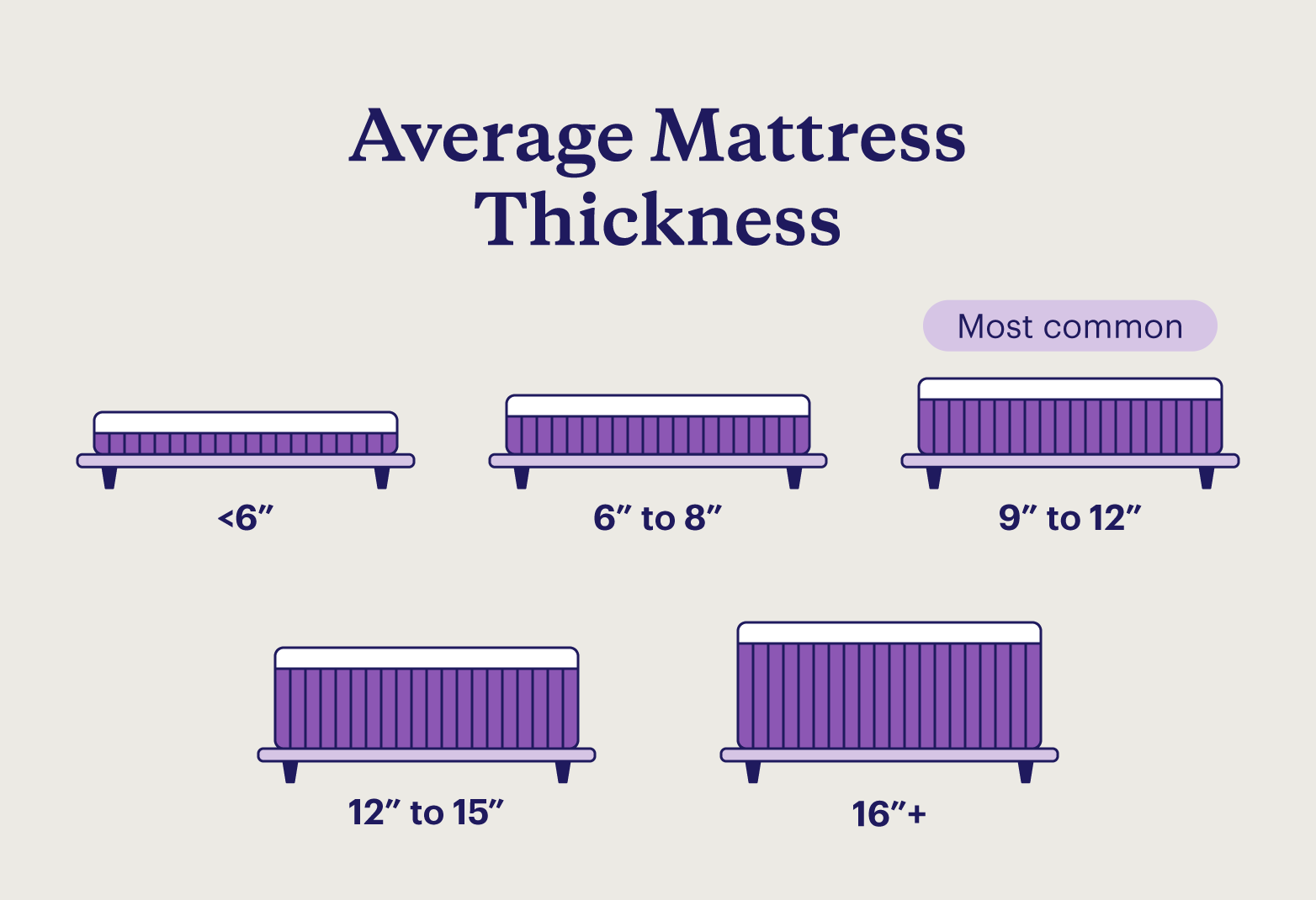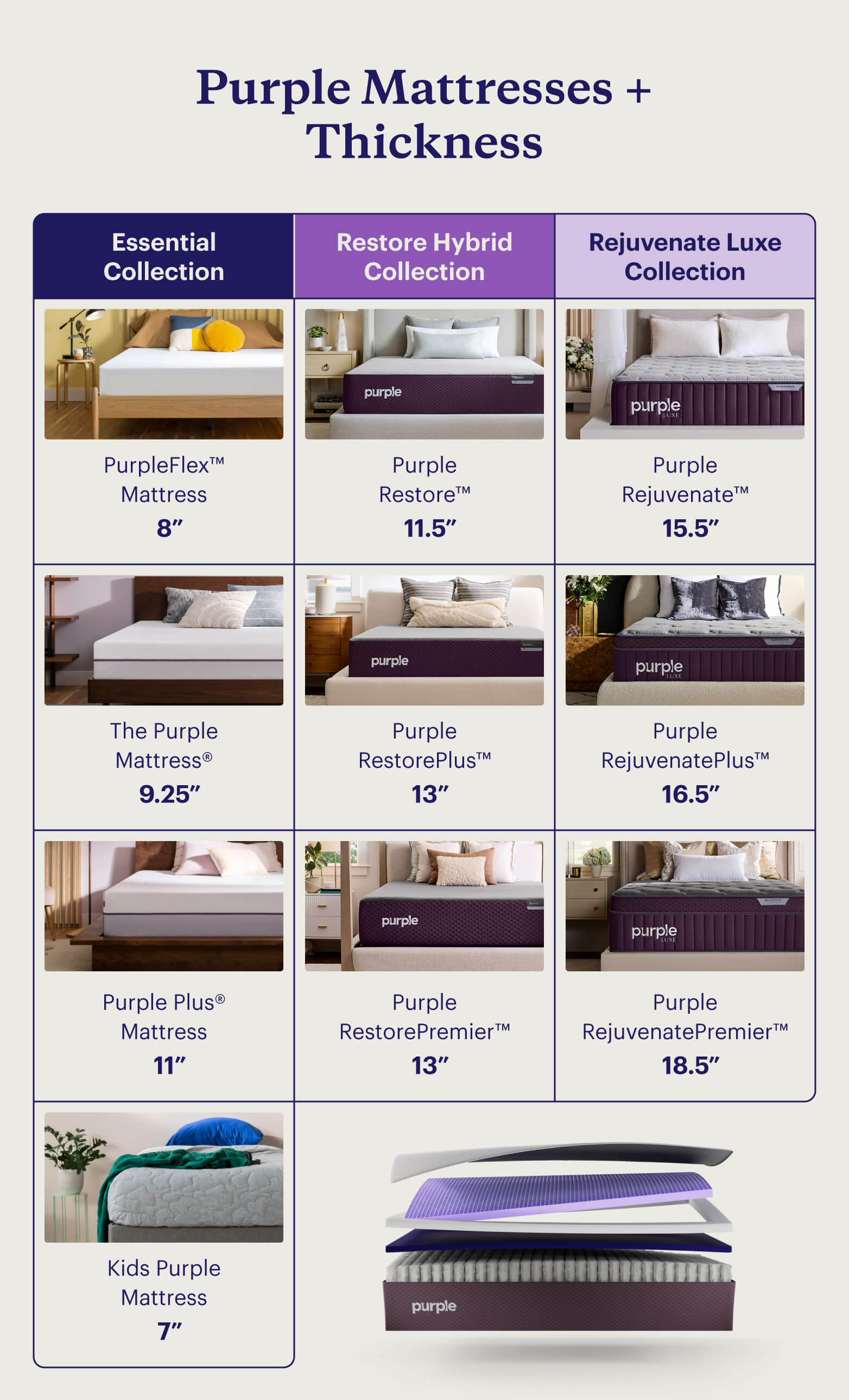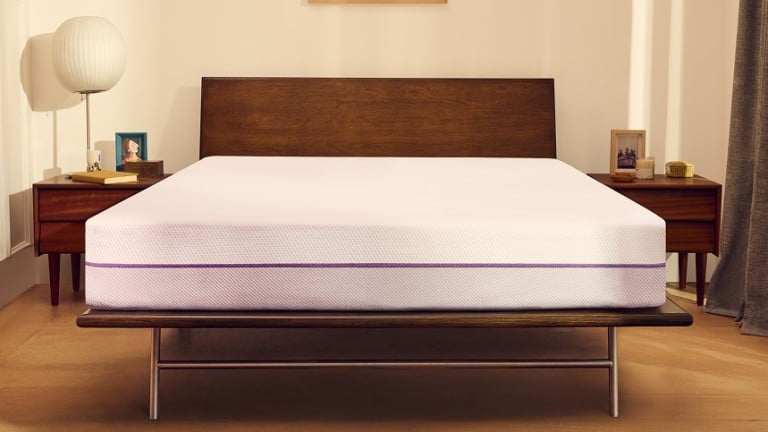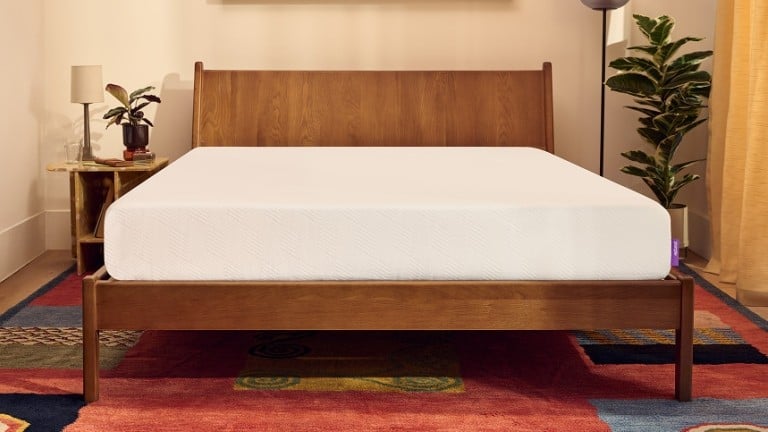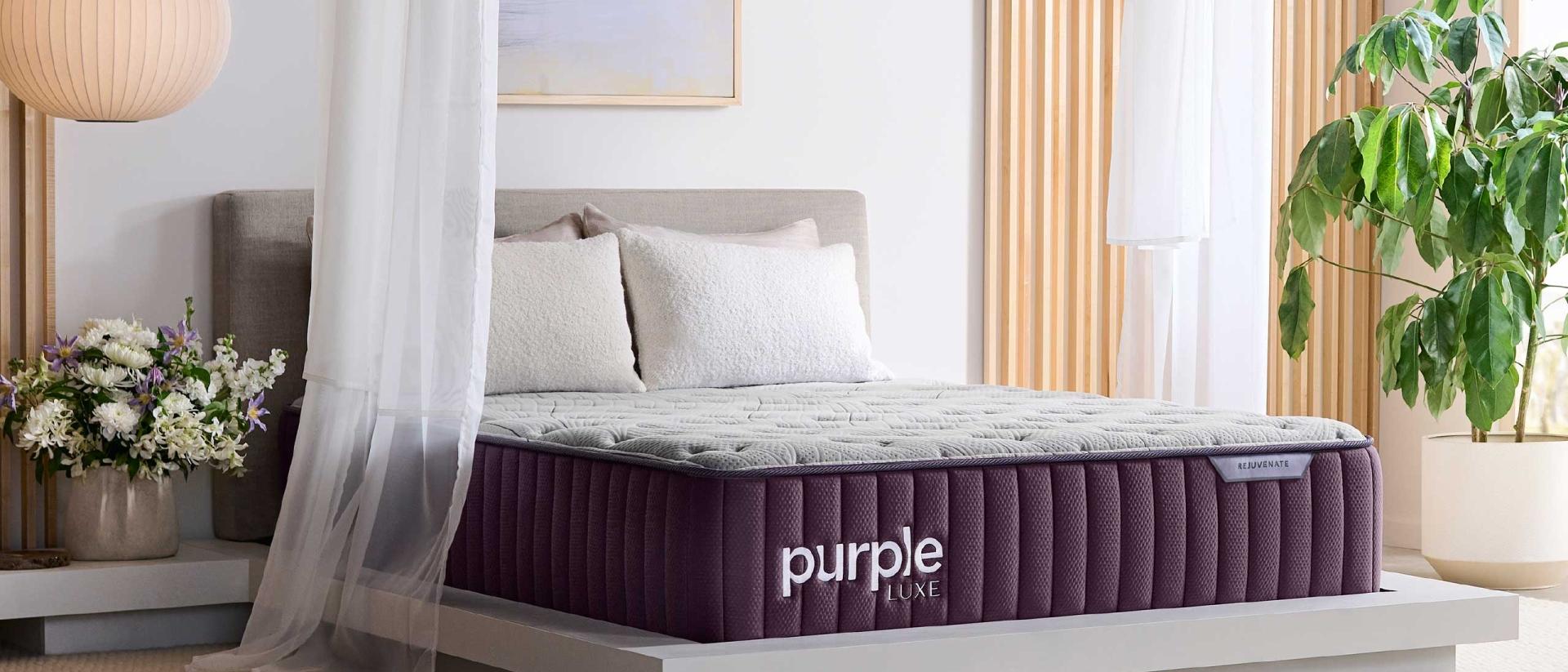
What’s the Ideal Mattress Thickness? [2025 Guide]
Key Takeaways:
- A mattress’s thickness is its depth measured without a foundation or bed frame.
- Average mattress thickness is between 9 and 12 inches, but slimmer and thicker mattresses exist for those who prefer them.
- It’s helpful to know your mattress’s thickness if bed height affects your ability to get in and out of bed or when shopping for bedding.
A comfortable mattress is essential for restful sleep, but choosing the right one is a process that takes time and thought. When selecting the right mattress, bed size and mattress type are typically top of mind, but mattress thickness and its impact on comfort is an often overlooked, but important factor. Your sleeping position, body weight, and preferred firmness level all factor into what mattress thickness will be best for you.
It’s important to note — there is no right or wrong answer for how thick your mattress should be. In this guide, we'll help you understand mattress thickness and how to choose a mattress thickness that feels best to you.
What Is Mattress Thickness?
Mattress thickness is the depth of a mattress without a bed frame or foundation. It is measured vertically from the top side of the mattress to the bottom edge. If you think of your fitted bed sheet, that’s what encloses your mattress’s depth.
Bed height, sometimes confused with thickness, differs in that it is the combined measurement of the bed’s depth and bed frame. Bed height refers to how high a mattress sits above the floor.
Thickness should also not be confused with size. Bed sizes are determined by the horizontal dimensions (i.e., width and length). The thickness of a mattress depends on the model, but for most models, every size has the same thickness — no matter if it's a twin, full, or California king mattress.
Mattress Thickness Chart
Mattresses are available in a range of thicknesses to accommodate individual sleepers’ needs and preferences. Standard, or the most common, mattress thickness falls between 9 to 12 inches.
The table below provides details on common thickness dimensions and when each type is most appropriate.
Thickness | Details | Works Well For |
| <6” | Minimal layers Often a firm feel Sleeper’s weight is a significant consideration | Young children Cribs (when approved after testing), trundles, or bunk beds (including RVs) |
| 6” to 8” | Fewer layers Accessible to those with limited mobility | Children Lightweight sleepers Those who prefer a lower bed height |
| 9” to 12” | Most common mattress thickness May include several layers for support and comfort Soft to firm feel range | Most adults Primary or guest bedrooms |
| 12” to 15” | Extra comfort and support layers Soft to firm feel range | Heavier adults Primary or guest bedrooms |
| 16”+ | Superior comfort and support layers Soft to firm feel range Resistant to sagging Not ideal for those with limited mobility Heavy | Heavier adults Those who prefer a tall bed height Primary bedrooms |
Factors That Influence Mattress Depth
Most mattresses on the market are multilayered with two to five (or more) layers. Each tier is typically made of a different material to target a specific sleep need. Mattress manufacturers categorize these layers into three types: comfort, transition, and base.
Comfort Layers
Comfort layers are the top one to three layers whose purpose is to create a comfortable surface for sleepers. This cushioning contours to the curves of the sleeper to relieve pressure points while also impacting the bed’s motion isolation, temperature regulation, and overall firmness.
Most mattresses’ comfort layers range from 1 to 7 inches thick, though this depends on the materials and model of the bed. Soft mattresses typically have an overall thicker or multiple comfort layer, whereas firm beds have less or thinner comfort layers. These layers are often made from:
- Memory foam
- Polyurethane foam
- Latex
- Gel
- Natural materials like cotton or wool
The comfort composition of Purple’s mattresses varies by model between foam and latex, though all Purple mattresses feature our proprietary comfort layer: GelFlex Grid®. Our patented Grid adapts instantly as you move, reconfiguring itself to support any position you take throughout the night ensuring blissful, uninterrupted rest.. A unique column structure and flexible formula create cradling comfort that relieves pressure while also maintaining support for optimal alignment — it’s a miracle of science.
If sleepers are not getting the sleep-changing balance of softness and support that only the GelFlex Grid® provides, they may opt to add a separate topper to make a firm mattress softer — typically when sleeping on a memory foam or innerspring bed. As a separate layer from the bed itself, it doesn’t increase the mattress’s thickness, but it does impact bed sheet fit and overall bed height.
Purple does not recommend using mattress toppers on Purple mattresses as they negate the GelFlex Grid®’s benefits.
Transition Layers
Sandwiched between comfort and base layers, transition layers add to the overall support of a mattress — hence why they’re oftentimes referred to as support layers. These crucial elements are designed to give underneath top comfort layers with the application of body weight, while gently pushing back for support.
Transition layers are often made from:
- Sturdy or medium-density foams
- Latex
- Innerspring coils
Purple mattresses use polyurethane foam edge support around the GelFlex Grid® to avoid dipping as you get out of bed. Our Restore® Hybrid and Rejuvenate® Luxe mattresses also feature an additional foam layer underneath the GelFlex Grid® as a supportive transition layer.
Some thin mattresses, particularly memory foam, do not have transition layers between comfort and base layers.
Base Layers
The bottom base layers contribute to a mattress’s support and durability. It is the firmest, sturdiest layer of a mattress’s composition. Base layers are often made from:
- High-density foam
- Latex
- Steel coils
- Combination of materials
Some mattresses, like Purple’s, may feature a combination of materials depending on the model. Purple’s Essential Collection mattresses offer a thick layer of supportive polyurethane foam as its base. Purple’s Restore® Hybrid and Rejuvenate® Luxe Collection mattresses feature responsive pocket coils with foam caps to support the comfort and transition layers.
Transition and base layers combined should account for at least half of the total mattress thickness.
Mattress Depth vs. Type
Mattress type refers to the materials a bed is made from. In general, mattress types are made of one primary material type, most commonly:
- Innerspring
- Foam
- Latex
Hybrid mattresses are the exception, combining several materials into one bed. The type of mattress can play into its thickness, though the depth can vary significantly between types depending on quality and construction.
Innerspring
Innerspring mattresses are beds that contain metal springs and coils within a cushioning fabric cover. Most innerspring mattresses consist of three layers: the top comfort layer, the coil transition core, and the bottom foundation base. The coils provide the classic springy feel, reminiscent of the quintessential bed children love to bounce on, even when the doctor tells them not to.
A greater number of coils typically results in a thicker, more supportive mattress. Mattresses that use short coils are thinner and less supportive. Some higher-end innerspring mattresses feature a plush pillow-top comfort layer, which increases mattress thickness. Innerspring mattresses are often paired with box spring foundations, which add to the overall bed height.
Foam Mattress
Foam mattresses are well known for their ability to conform to the curves of a sleeper’s body. This allows for proper spinal alignment and support through even body weight distribution.
Some of the most common types of foam used in mattresses include:
- Memory foam
- Petroleum-based foam
- Polyurethane foam
- Latex foam
- Plant-based foam
- Gel foam
Foam mattresses come in all thicknesses. A memory foam mattress can be just as thick as a latex foam mattress. The overall depth depends on how many comfort and transition foam layers it has and the individual thickness of each layer. Foam mattresses also come in different firmness levels.
Purple’s Essential Collection mattresses fit closest to a foam mattress, but are not 100% foam. They are built with layers of polyurethane foam in addition to the hyper-elastic polymer GelFlex Grid®.
Latex
Latex mattresses use either synthetic or natural latex (rubber) to create a comfortable, responsive sleeping experience. They are known for their durability, motion isolation, and cooling abilities. Again, their thickness correlates with how many individual layers make up the mattress, but most fall within standard mattress thickness.
Some of the most common types of latex mattresses are those made of:
- Talalay latex (100% or blended)
- Dunlop latex (100% or blended)
- Styrene-butadiene rubber
Natural latex is a common allergen. Those with a severe latex allergy should avoid mattresses containing this type of foam or consult your doctor before it comes time to buy a new mattress.
Hybrid
Hybrid mattresses combine either foam or latex with springs. Their unique construction offers the airflow and support of traditional spring mattresses and the softness and responsiveness of foam.
All of Purple’s mattresses within our Restore® Hybrid and Rejuvenate® Luxe Collections are hybrid mattresses featuring layers of polyurethane foam, hyper-elastic polymer GelFlex Grid®, and individually wrapped edge-to-edge coils.
Adjustable
Adjustable beds are those that sit on an adjustable bed frame. The base is what allows sleepers to rest in an inclined position at the head and sometimes feet.
Although adjustable beds aren’t a type of mattress material, mattress thickness does play an important role in whether a mattress is suitable for an adjustable base. You don’t necessarily need a special mattress for an adjustable base, but you do need one that’s compatible and thin enough to bend with the base’s incline settings. Some thicker mattresses aren’t flexible enough to do this.
How To Choose Your Mattress Thickness
It can be helpful to know your ideal mattress thickness when shopping for a new bed. To pick the most appropriate mattress thickness for you, consider your sleeping position, body type, preferred firmness, bed frame height, age, and sleeping partners.
1. Consider Your Sleeper Type and Position
Picking a mattress based on your sleeping position may help you achieve more restful sleep. Here’s what we recommend for mattress thickness based on sleeping position:
- Side sleeper: A mattress with a thick comfort layer will cradle your hip and shoulder pressure points. In general, it's best to choose a mattress that’s at least 10 inches thick.
- Back sleeper: Opt for a mattress that’s over 8 inches thick with a medium or firm comfort layer and a superior support base to keep your spine aligned while you sleep.
- Stomach sleeper: Choose a mattress that’s over 8 inches thick with a firmer comfort layer and superior support base layers. This will keep your hips from sinking and prevent lower back pain.
- Combination sleeper: Since you toss between positions, it’s best to sleep on a mattress that’s 9 inches or thicker with excellent comfort and support layers.
2. Choose Your Ideal Firmness Level
A supportive mattress should be firm enough to relieve pressure points while you sleep. If it's too soft, you risk straining your back and neck. Meanwhile, mattresses that are too firm may leave you with joint pain.
Firmness levels can be measured on a scale from 1 to 10. The lower levels are softer, while the higher ones are firmer. Both soft and firm mattresses can have different compositions, materials, and thicknesses, so how tall a mattress is doesn’t always correspond to the feel.
For more information on firmness, check out our mattress firmness guide.
3. Factor in Your Body Size and Weight
Aside from sleeping position and comfort preferences, your body type plays a role in what mattress thickness and overall bed height might work best for you.
Although mattresses come with maximum weight limits, heavier people may find thicker mattresses offer the necessary support for good, uninterrupted sleep. Matching your and your sleeping partner’s body weight to a mattress can also help maintain the bed’s durability.
Similarly, tall individuals may prefer a thicker mattress that sits up higher so that it’s easy to get into bed, and vice versa for shorter people and a thin mattress.
4. Think About Your Age and Health
As we age, our mobility declines, making it more difficult to get in and out of bed. A mattress that’s too low or too high doesn’t make it any easier. Older individuals should consider a thinner or standard mattress thickness paired with an average bed frame height or one with adjustable legs that a family member can assist in lowering.
Similarly, those with physical mobility concerns outside of age should consider a thin, firmer mattress that’s easy to move around in.
Beyond age and mobility, your body’s physical health should also be a consideration. For example, if you suffer from nightly hip or shoulder pain, a mattress with thick comfort layers may help alleviate some of that pain.
5. Add Your Bed Frame and Foundation Height
Once you’ve determined whether you prefer a lower or higher mattress, you need to factor in the height of your bed frame and mattress foundation. For example, if you require a low bed, then you may want to consider a slimmer mattress on an average bed frame, or a standard mattress thickness paired with a low platform base. Choosing a bed frame that supports your mattress will ensure you get the most benefit from your bed and avoid excessive wear and tear.
Purple offers a variety of bed frames to suit all sleeper needs. Whether you’re looking for an adjustable base with modifiable leg height or a complete yet minimalist foundation, Purple has you covered.
Purple Mattress Thickness
Purple offers mattresses of all thicknesses — from our Essential Collection including mattresses with standard thickness, to our Rejuvenate® Luxe Collection carrying thicker beds.
Though the exact layer differences between Purple's mattresses vary by model, all Purple mattresses feature our proprietary, sleep-changing GelFlex Grid®. This patented hyper-elastic polymer provides the comfort and support required by every sleeper. It conforms with pressure, cushioning around hips and shoulders while maintaining support across broad surfaces such as legs and back. It adapts instantly to movement, ensuring uninterrupted sleep while thousands of air channels promote optimal temperature. This is sleep innovation at its best.
The GelFlex Grid® adds between 2 and 4 inches of comfort to the mattress’s thickness, depending on the model. The table below breaks down how thick Purple mattresses are by model.
Model | Thickness |
| PurpleFlex® Mattress | 8” |
| The Purple Mattress® | 9.25” |
| Purple Plus® Mattress | 11” |
| Restore® Hybrid | 11.5” |
| RestorePlus® Hybrid | 13” |
| RestorePremier® Hybrid | 13” |
| Rejuvenate® Luxe | 15.5” |
| RejuvenatePlus® | 16.5” |
| RejuvenatePremier® | 16.5” |
| RejuvenateUltimate® | 17.5" |
Find Your Ideal Mattress Thickness With Purple
Whether you prefer a mattress thickness that’s thinner than 8 inches, average like 10 or 12 inches, or thicker than 16 inches, Purple has a mattress for you. Sleep better at night on a Purple mattress with our exclusive GelFlex Grid®. Our beds are designed to dissipate heat and instantly adapt to your movement without disrupting your sleeping partner.
FAQ
Standard or average thickness depends on the mattress type. The average thickness for an all-foam mattress is 9 to 12 inches. Meanwhile, the average thickness of a hybrid model is 11 to 13 inches. Purple mattresses range from 8 to 18.5 inches thick.
It’s best for adults to sleep on a mattress that is at least 8 to 10 inches thick. Exceptions include children or those with mobility concerns.
The thickness of a mattress’s base layer — not necessarily the bed’s overall thickness — affects durability. A thicker, superior base layer provides more support and can withstand longer use or heavier weights.
Mattress thickness is related to mattress firmness and density. In general, you can expect a softer mattress to be thicker and a firmer mattress to be thinner if they are made from the same materials.
A 9-inch mattress may be thick enough for you, particularly if you’re a back or stomach sleeper with a small to average body type and minimal aches and pains day-to-day. If you sleep on your side, are heavier, or deal with joint pain, a thicker, more supportive mattress may be better for you.
Yes, a 14-inch mattress is considered thick. A thick mattress may range from 12 to 15 inches.
More to Explore
Level-up your sleep routine with our most-loved products.

